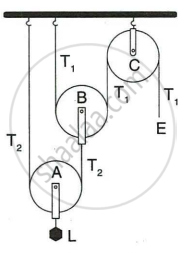Advertisements
Advertisements
प्रश्न
A boy uses a single fixed pulley to lift a load of 50 kgf to some height. Another boy uses a single movable pulley to lift the same load to the same height. Compare the effort applied by them. Give a reason to support your answer.
उत्तर
The ratio of load to the effort is called the mechanical advantage.
Mechanical advantage (MA) = `"Load(l)"/"Effort(E)"`
The above equation indicates that 'MA' and 'Effort' are inversely proportional.
The mechanical advantage of the single fixed pulley is 1.
For, single movable pulley = 50 kgf
:. Effort (Esingle fixed pulley) = `"Load"/(MA_"single fixed pulley")`
= `50/1 = 50` kgf
Effort (Esingle fixed pulley) = `"Load"/(MA_"single movable pulley")`
= `50/2 = 25` kgf
Therefore, the boy using a single movable pulley requires lesser effort to lift an equal load of 50 kgf when compared with the effort required by the boy using a single fixed pulley.
APPEARS IN
संबंधित प्रश्न
State two functions of a machine.
What is the mechanical advantage of an ideal pulley?
Differentiate between a single fixed pulley and a single movable pulley.
Define the following term in reference to a gear system for Gain in torque ?
What should be the gear ration of a car : equal to 1, less than 1 or greater than 1, while ascending a hill ?
The diagram below shows an arrangement of three pulleys A, B, and C. The load is marked as L and the effort as E.
- Name the Pulleys A, B, and C.
- Mark in the diagram the directions of load (L), effort (E) and tension T1 and T2 in the two strings.
- How are the magnitudes of L and E related to the tension T1?
- Calculate the mechanical advantage and velocity ratio of the arrangement.
- What assumptions have you made in parts (c) and (d)?

A block and tackle pulley system has a velocity ratio 5. Draw a labelled diagram of this system. In your diagram, indicate clearly the points of application and the directions of the load and effort.
The mechanical advantage of an ideal single movable pulley is ______.
What is a block and tackle system of pulleys?
State two reasons, why the efficiency of a pulley system is not 100 percent?
